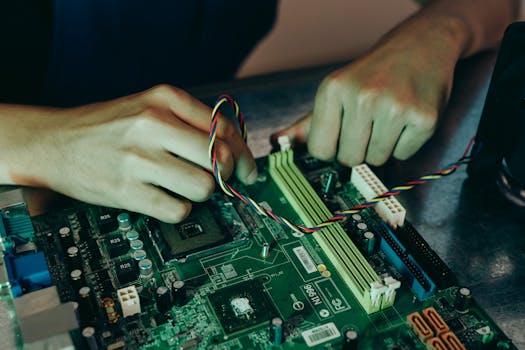
**
The artificial intelligence (AI) revolution is upon us. From self-driving cars to medical diagnoses, AI is rapidly transforming industries across the globe. Businesses are scrambling to integrate AI into their operations, driven by the promise of increased efficiency, improved decision-making, and groundbreaking innovation. But this frantic race towards AI adoption is revealing a critical vulnerability: a massive shortfall in the essential infrastructure required to support the technology's burgeoning demands. Without the right foundation – from specialized AI chips to robust cooling systems – most companies risk being left behind in this transformative technological race.
The AI Infrastructure Gap: A Critical Bottleneck
The sheer computational power needed to train and run advanced AI models is astronomical. This necessitates a significant upgrade in infrastructure, an area where many companies are falling short. This gap isn't just about having enough servers; it's about a sophisticated interplay of various elements:
The Chip Shortage: Powering the AI Engine
At the heart of every AI system lies the processing unit. While traditional CPUs are capable of handling some AI tasks, the true powerhouses are specialized AI accelerators, primarily GPUs (Graphics Processing Units) and increasingly, ASICs (Application-Specific Integrated Circuits) and FPGAs (Field-Programmable Gate Arrays). These chips are specifically designed to handle the complex mathematical calculations required for machine learning algorithms. However, a global shortage of these specialized chips is hampering the widespread adoption of AI. The high demand, coupled with manufacturing complexities and geopolitical factors, is creating significant delays and driving up prices, making it challenging for many companies to acquire the necessary computing power.
Cooling Challenges: Keeping AI Cool Under Pressure
High-performance AI chips generate immense heat. This heat necessitates sophisticated data center cooling systems to prevent overheating and ensure optimal performance. Traditional cooling methods often struggle to keep pace with the thermal output of modern AI hardware, leading to reduced efficiency, system failures, and increased energy consumption. This is pushing companies to invest in advanced cooling solutions, such as liquid cooling and immersion cooling, which are more expensive and complex to implement. The sustainability aspect of these cooling systems is also a growing concern, requiring companies to find solutions that minimize their environmental impact.
Data Storage: The Unsung Hero of AI
The vast amounts of data required to train and operate AI models necessitate equally robust data storage solutions. High-performance storage systems, such as NVMe SSDs and specialized cloud storage platforms, are critical for ensuring fast access to data. The increasing volume and velocity of data are pushing the boundaries of existing storage infrastructure, requiring businesses to invest in scalable and efficient solutions. Effective data management and data governance are also critical to ensuring data quality and security in this context.
Network Infrastructure: Connecting the Dots
AI systems often rely on interconnected networks to access data and communicate with other systems. High-bandwidth, low-latency networks are critical for optimal performance. The increasing demand for AI is straining existing network infrastructure, requiring upgrades to accommodate the increased traffic and data transfer rates. This includes investments in 5G networks, edge computing, and high-speed interconnects within data centers.
The Business Implications of the Infrastructure Gap
The lack of appropriate infrastructure is not simply a technical challenge; it has significant implications for businesses:
- Delayed AI projects: The scarcity of AI chips and other resources can lead to significant delays in AI project deployment.
- Increased costs: The high cost of specialized hardware and cooling systems can make AI adoption prohibitively expensive for many companies.
- Limited scalability: Inadequate infrastructure can hinder the ability to scale AI applications to meet growing business needs.
- Competitive disadvantage: Companies that fail to secure adequate AI infrastructure risk falling behind competitors who are able to leverage the power of AI more effectively.
- Security vulnerabilities: Without robust infrastructure, businesses may struggle to ensure the security and integrity of their AI systems, potentially exposing themselves to cyberattacks.
Overcoming the Infrastructure Hurdles: Strategies for Success
While the challenges are significant, there are strategies businesses can employ to overcome the infrastructure gap:
- Strategic partnerships: Collaborating with cloud providers or specialized AI infrastructure companies can provide access to the necessary resources without the need for significant upfront investment.
- Optimization and efficiency: Employing techniques such as model compression and quantization can reduce the computational resources required for AI operations.
- Hybrid cloud strategies: Combining on-premise infrastructure with cloud resources can provide a flexible and cost-effective solution.
- Investment in skilled workforce: Companies need to invest in training and development to build a workforce with the expertise to manage and maintain complex AI infrastructures.
- Long-term planning: Businesses must adopt a long-term perspective on AI infrastructure planning, anticipating future needs and making proactive investments.
The AI revolution is undeniably transformative. However, for businesses to truly capitalize on its potential, they must address the critical infrastructure challenges that are currently hindering widespread adoption. By strategically addressing these issues, companies can position themselves to not only survive but thrive in the burgeoning AI landscape, avoiding the risk of being left in the dust. Ignoring the infrastructure requirements will only lead to missed opportunities and potentially crippling competitive disadvantages in the coming years.




















